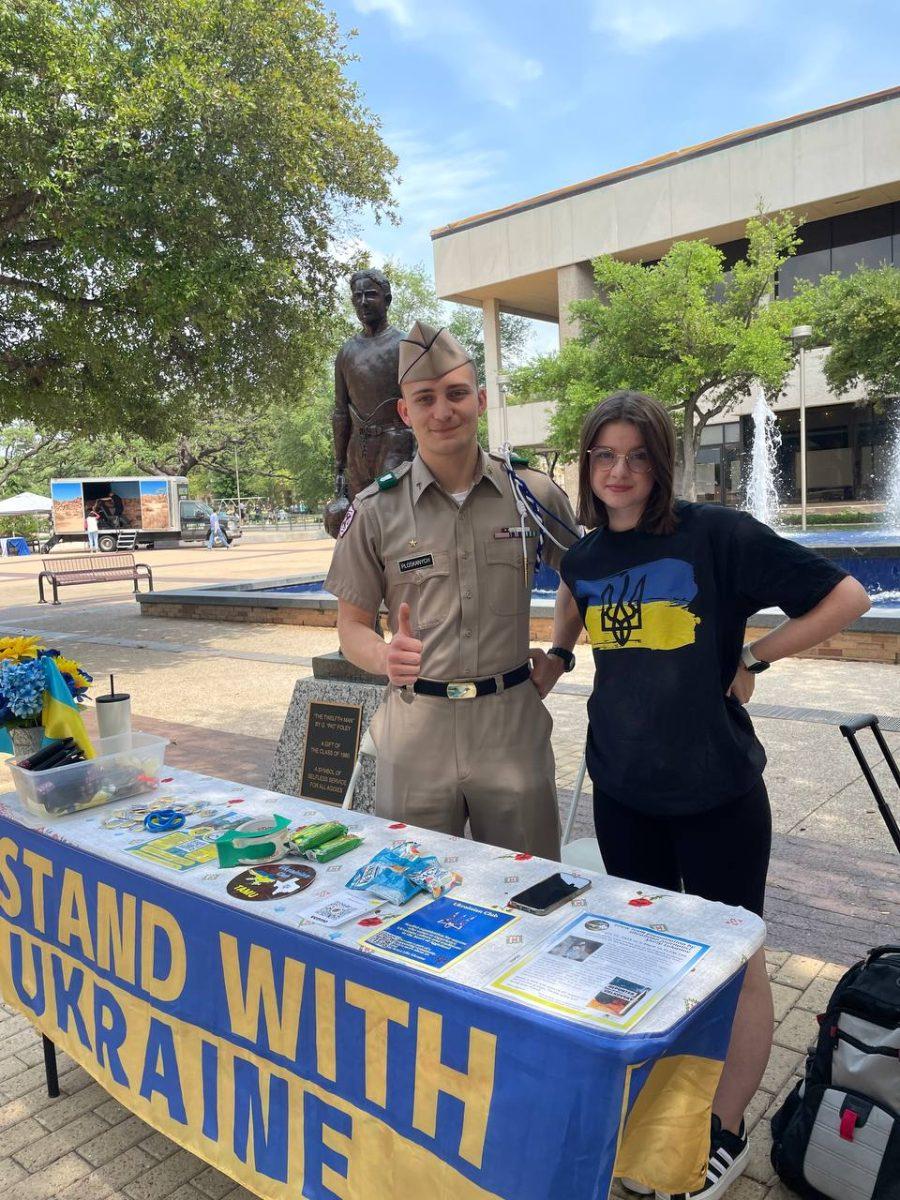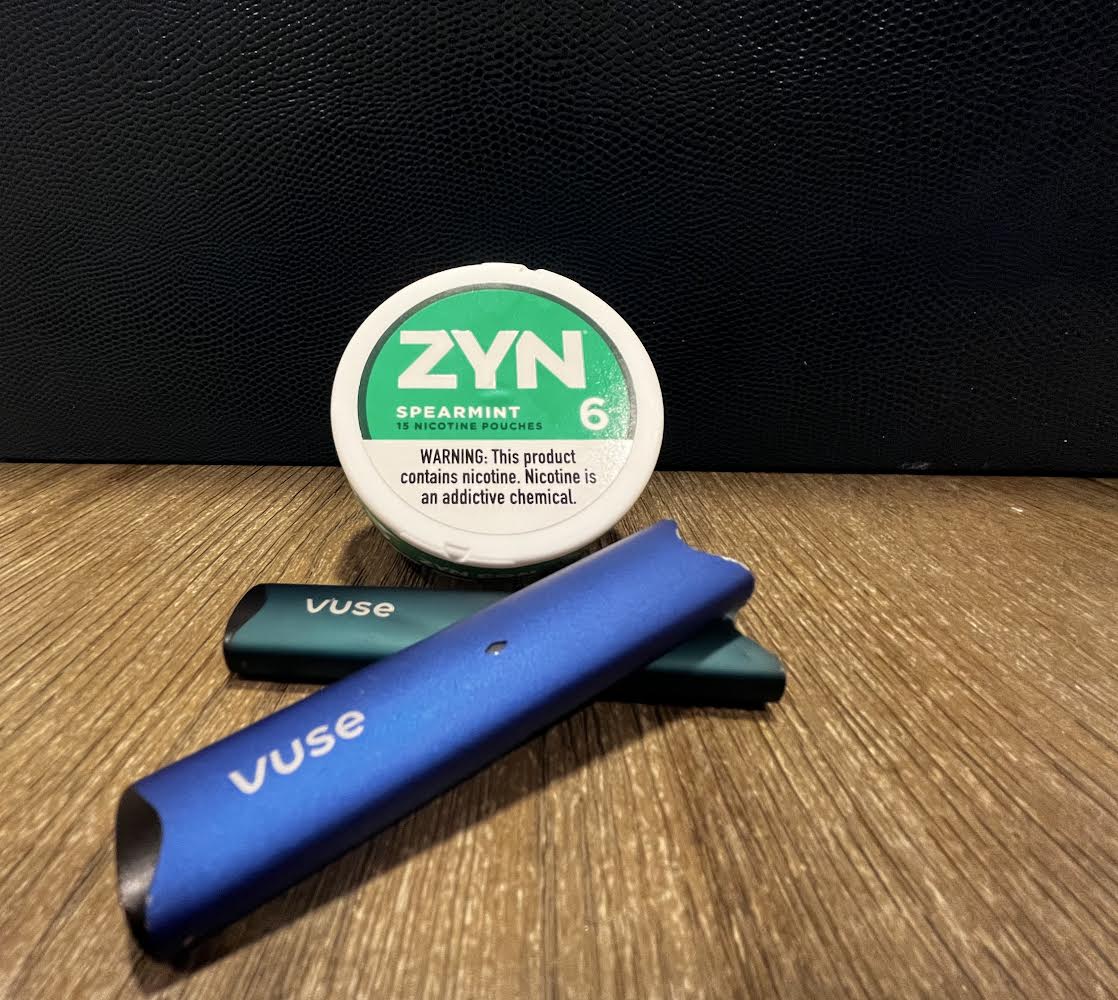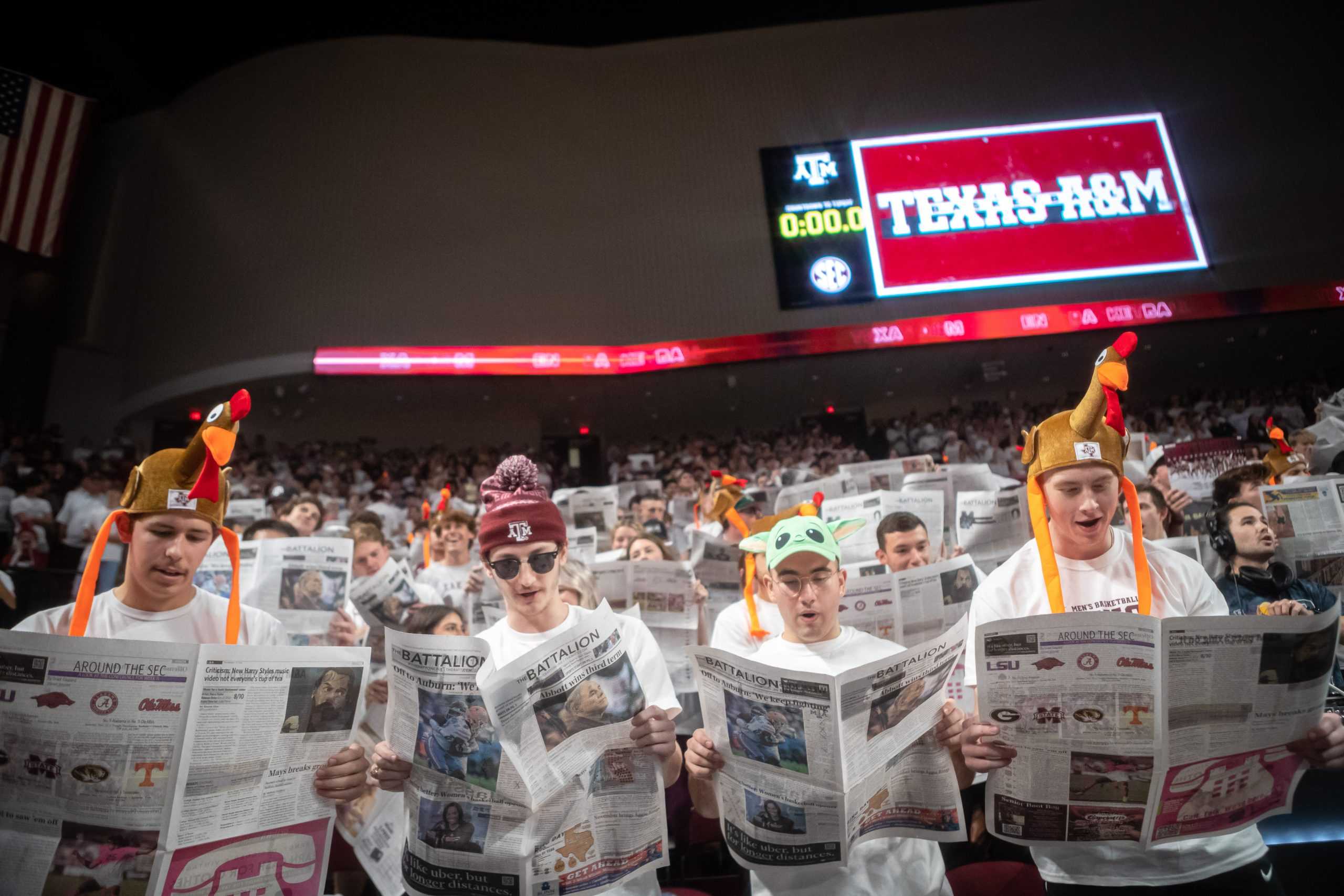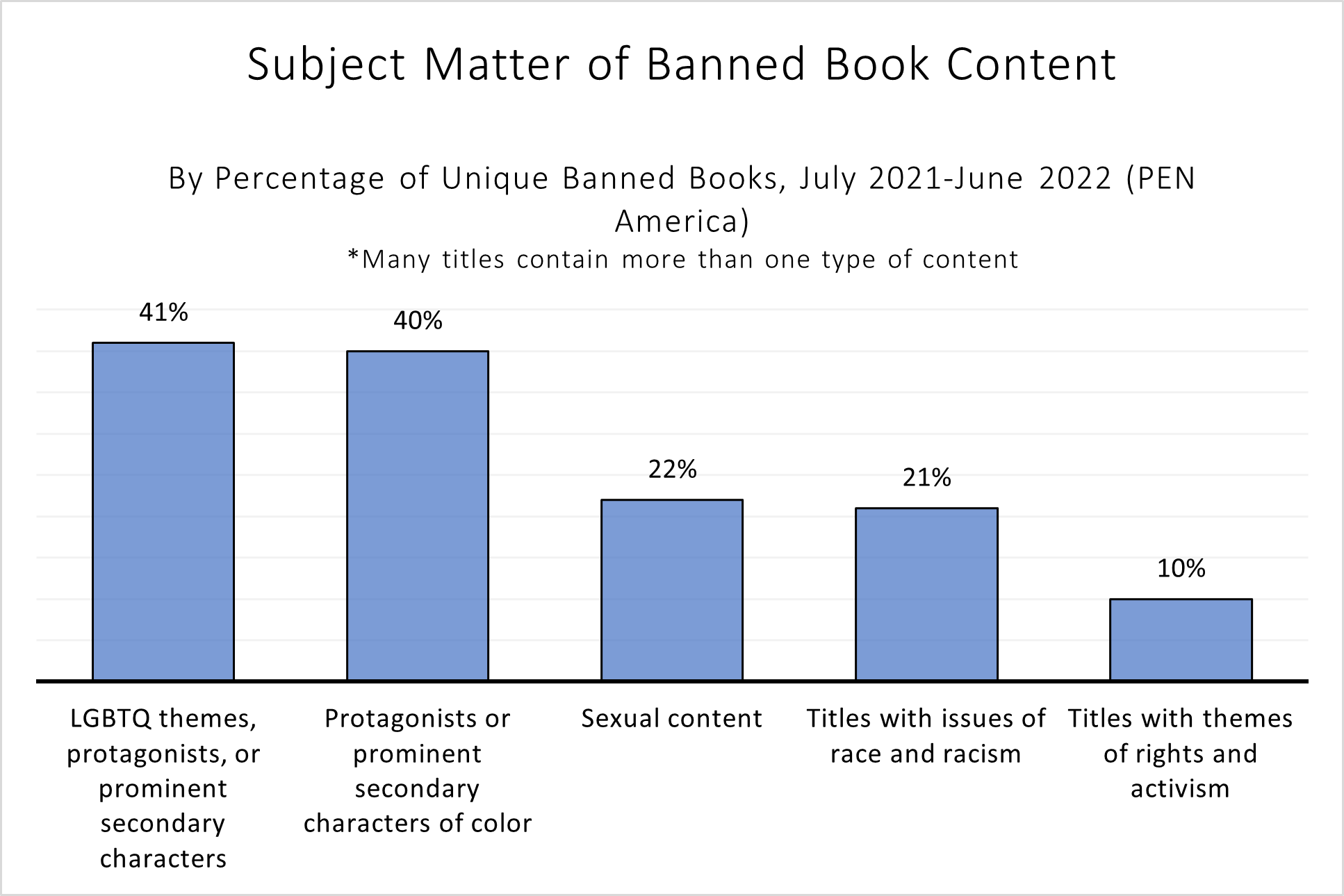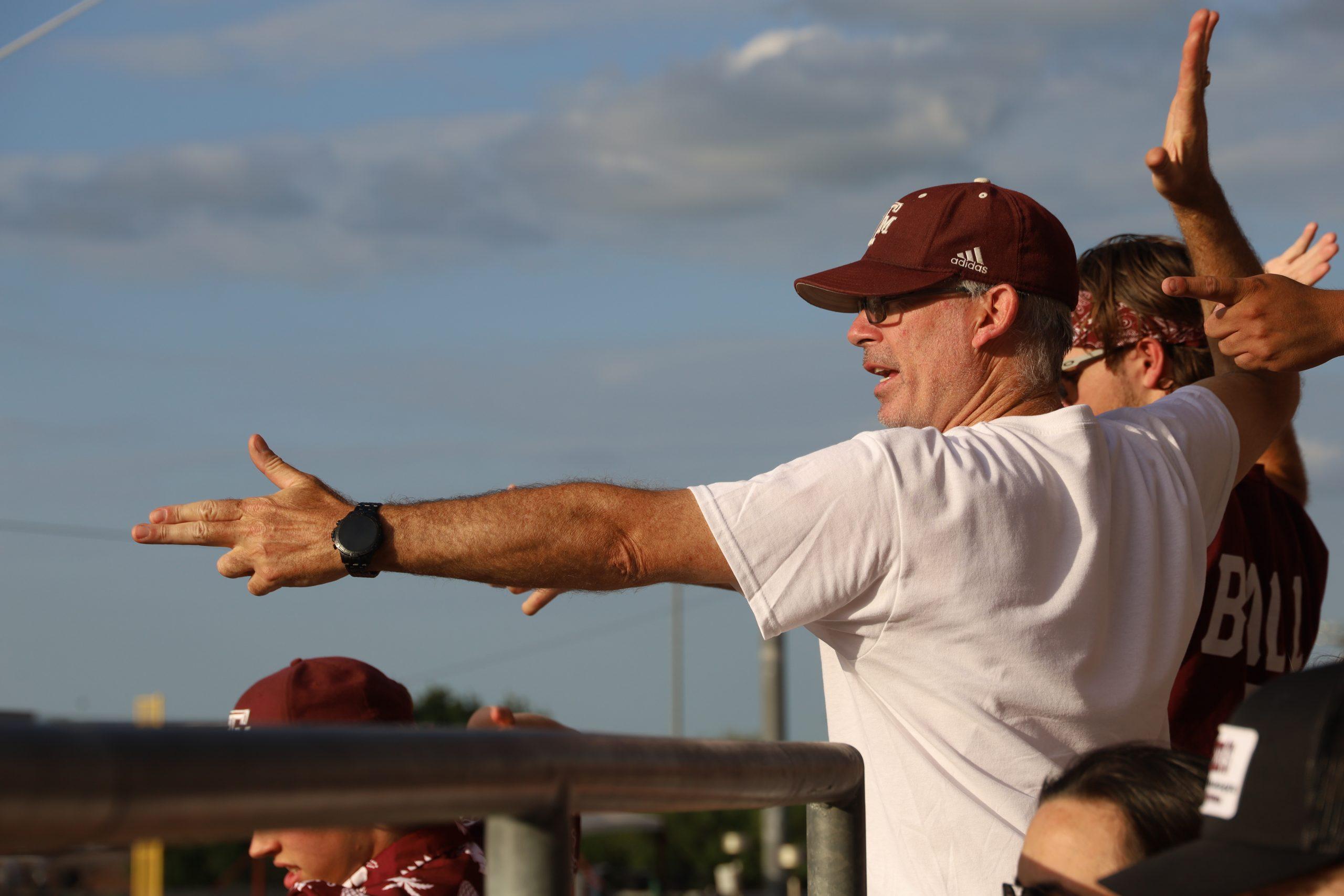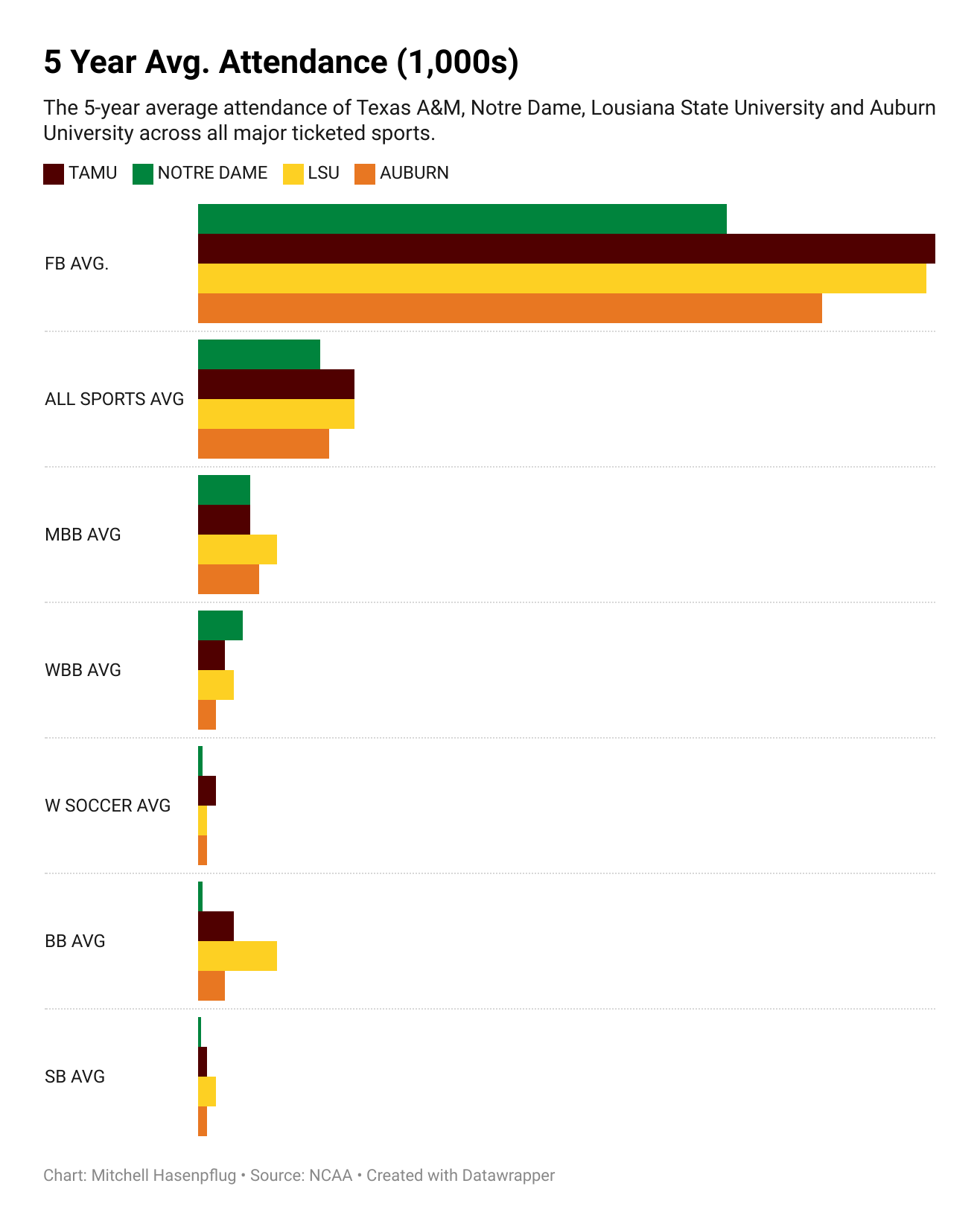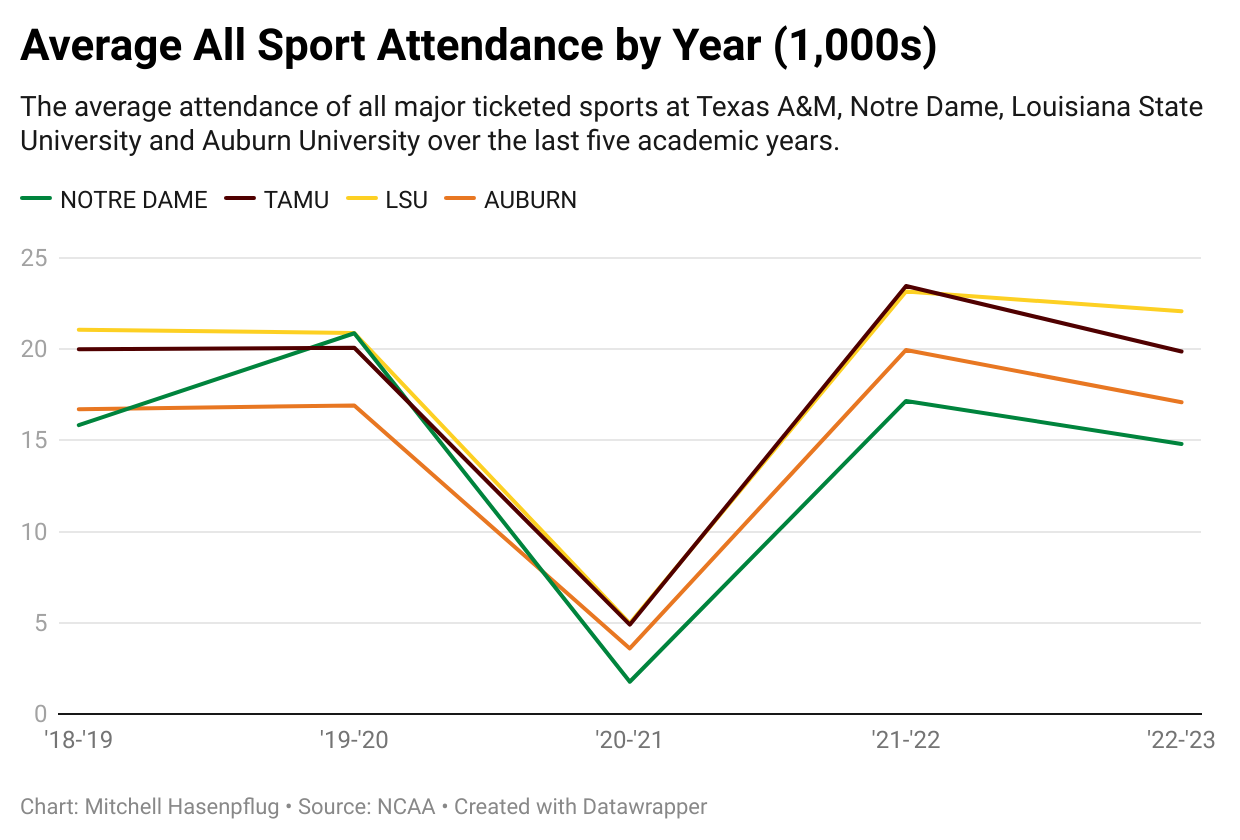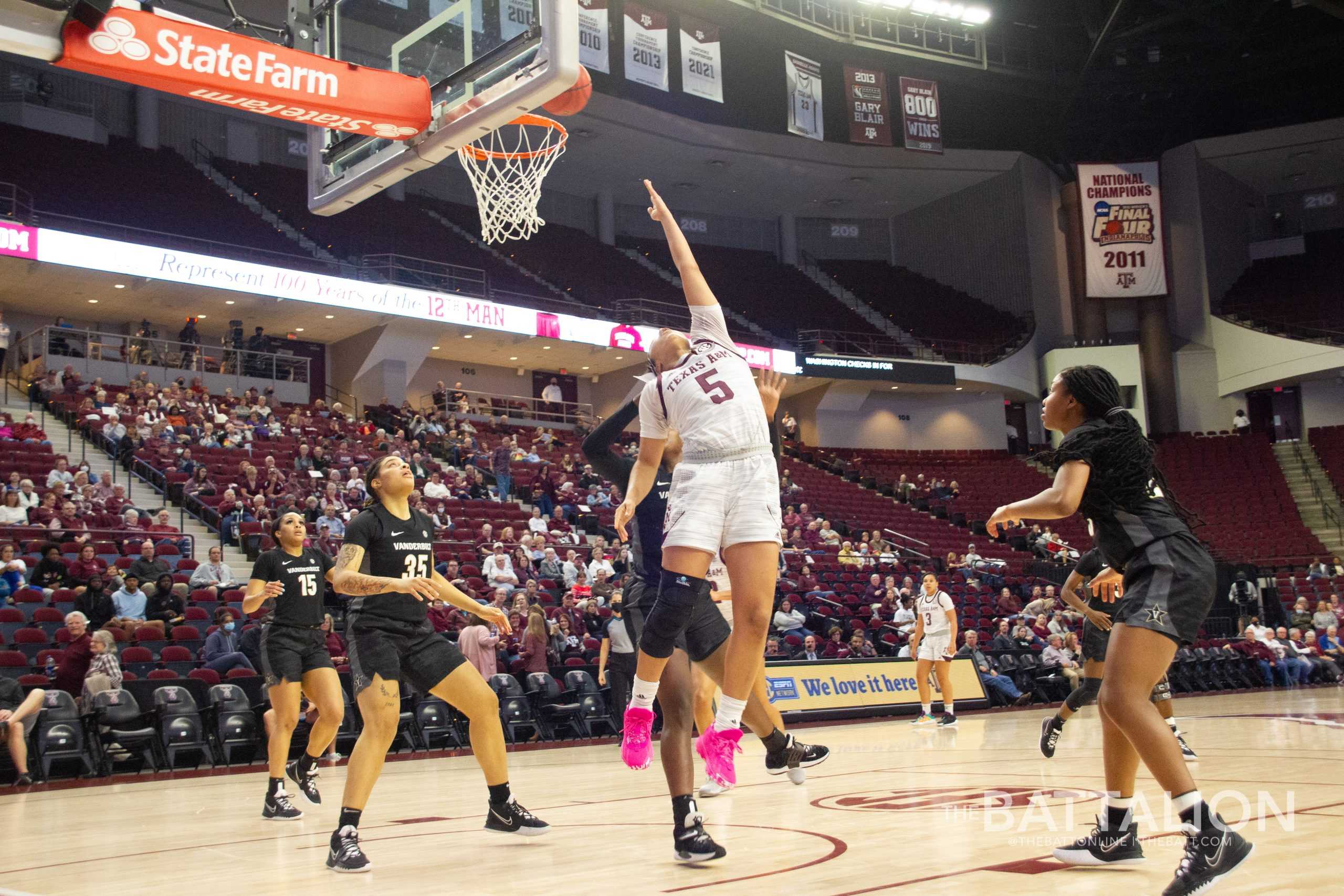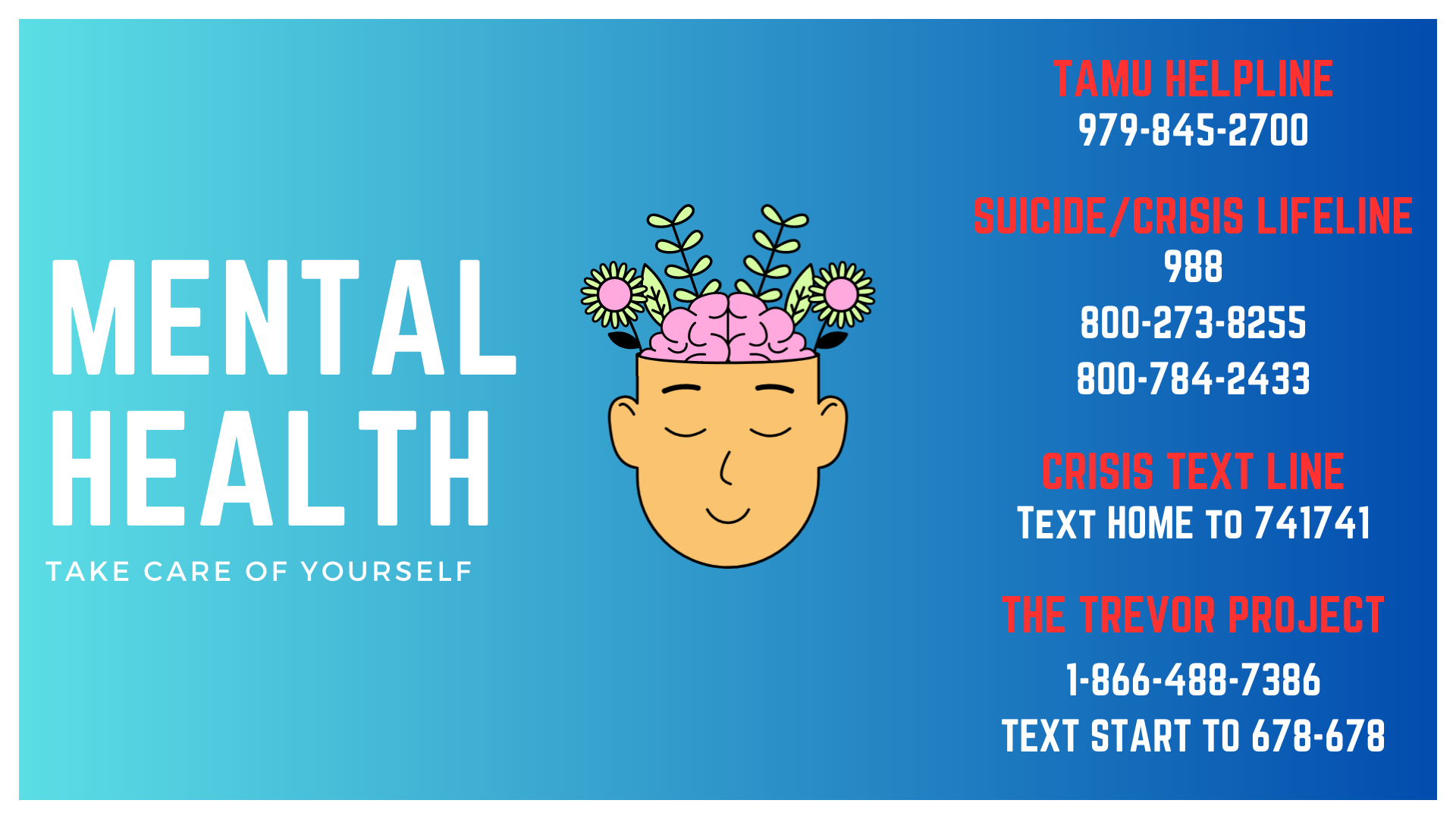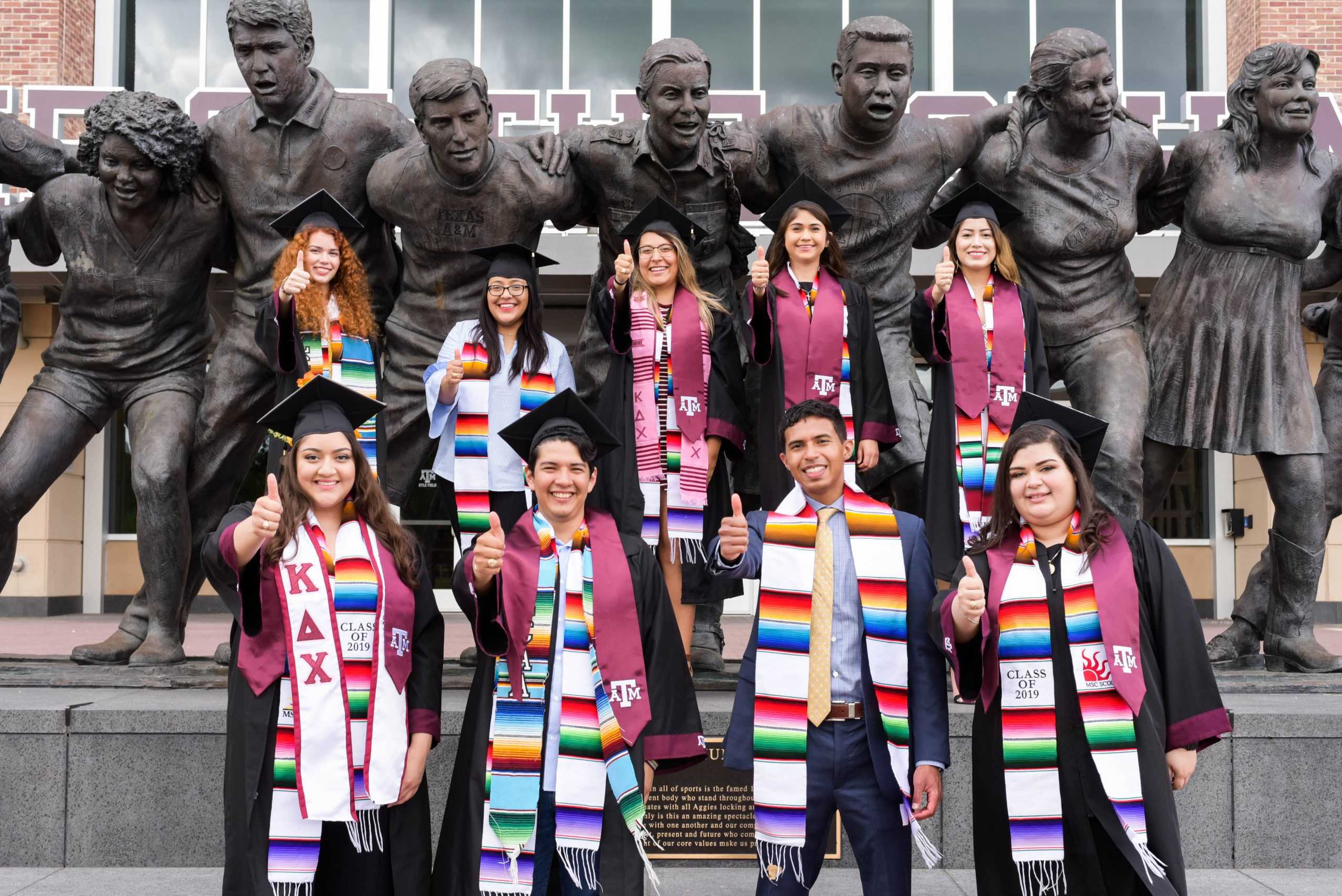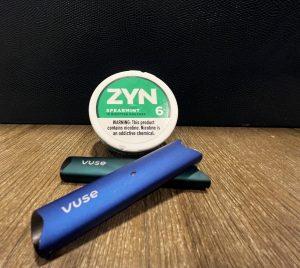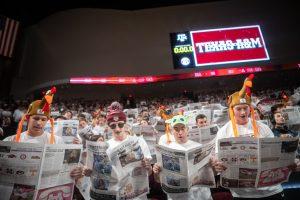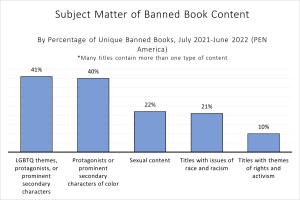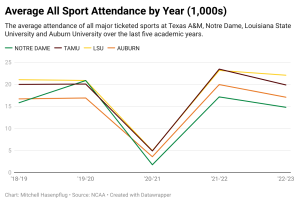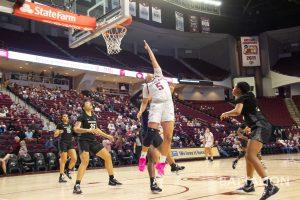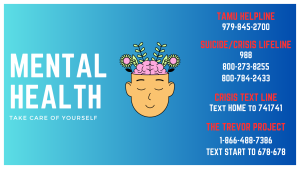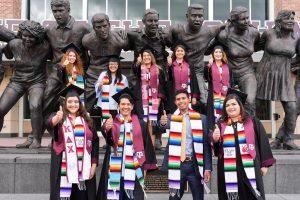This semester, the various sections of JOUR 203, Media Writing I, coordinated with The Battalion to select a proportion of each section’s final longform reporting projects to be submitted as a web package.
Professors Angelique Gammon, Larry Lemmons and Hannele Rubin submitted articles that included a local angle of a national topic, that were written in an accurate, interesting media style format. Students had to submit photo or other artwork to be considered for publication. These final projects required expert sources and relevant data to provide context to explain issues of interest to The Battalion’s audience.
Each of the 12 pieces selected can be viewed by pressing the “next” button on the top right of the article.
Texas A&M gives Ukrainian students refuge from war
By Nadia Abusaid, JOUR 203 contributor
The sound of explosions early one morning in 2022 jolted Natalya Kolomiyets awake; planes were dropping bombs around her home in Kharkiv, Ukraine. The war with Russia had come to her town.
She frantically stuffed clothes, chargers and important documents into her backpack. As she packed to leave with her mother and two younger sisters, Kolomiyets didn’t know that it would be the last time she would be in her childhood home.
The next morning, the family traveled to a countryside home to escape the bombing. There, Kolomiyets huddled in one room with 12 other people. Her family then fled to Hungary and eventually to Germany before arriving in College Station on April 4, 2022.
Before leaving Ukraine — before her life was turned upside down — Kolomiyets attended one of Ukraine’s top universities, majoring in business administration. Now, Kolomiyets is a sophomore economics major at Texas A&M and the vice president of the A&M Ukrainian Club. Kolomiyets works with the president of the club, Volodymyr Ploskanych, to fundraise and provide aid for Ukrainians and spread awareness of the conflict.
The conflict began in 2014, when Russia invaded Crimea, and Russian-backed separatists in the Donbas region held a secession referendum, according to the Council on Foreign Relations, a non-partisan think tank. At the time, Russian President Vladimir Putin attempted to justify the illegal annexation of the Ukrainian territory as a way to “ensure that [Russian citizens’] rights and interests are fully protected,” said Putin in a speech to a joint session of the Russian parliament.
“This conflict has been going on now for eight years but it intenstfied dramatically last February,” said Larry Napper, former U.S. ambassador and A&M professor emeritus.
By the beginning of 2022, more than 100,000 Russian troops had positioned themselves near the Russian-Ukrainian border, according to the New York Times. The U.S. took note of this and predicted Russia would invade, said Napper.
Napper, who specialized in foreign relations at the Bush School, said the invasion began on Feb. 24, 2022, based on Putin’s unilateral decision. Troops began attacking major cities including the capital, Kyiv, Napper said.
“[Putin] gave the orders and they obeyed,” Napper said.
Since Russia began its invasion of Ukraine, nearly four million refugees have fled the country, according to the latest estimate from the United Nations High Commissioner for Refugees. Most have fled to neighboring Poland, and many have gone on to other host countries around the world.
In response to the conflict, U.S. President Joe Biden began the Uniting for Ukraine program on April 22, 2022, to help Ukrainian citizens fleeing from the war, according to U.S. Citizenship and Immigration Services. The program allows Ukrainian citizens and their immediate family members to enter the U.S. on a two-year parole, with the condition that they have a financial supporter in the U.S. who is willing to help them during their stay.
During the 2021-22 academic year, 1,835 students from Ukraine studied at U.S. universities, a 5.5% increase from the previous years, according to Open Doors, a non-profit funded by the U.S. Department of State. Just over a third of those universities provided tuition waivers or scholarships to Ukrainian students. Fewer than a third waived application fees or provided work-study opportunities, and only 9% offered room and board, according to the Institute of International Education’s 2022 Report.
After Russia’s invasion, A&M Chancellor John Sharp “ordered all ties with Russia to be severed,” in a letter to the presidents of the A&M University System. Sharp urged the system’s presidents to push back against Putin’s “illegal and immoral” attack on Ukraine.
Later, Sharp decided to tap into a scholarship fund “to offer free tuition, fees and limited living expenses to all current students from Ukraine,” he announced in a letter on March 29, 2022.
The A&M University System identified at least 14 students to receive the scholarship, and agreed to pay up to $25,000 in tuition and living expenses.
Sharp also agreed to “open up university facilities to accommodate a few displaced Ukrainian professors and students” so that they may continue their research, which he said would benefit the school system. The financial aid came from the A&M Board of Regents Grant, a program initially designed to help students with Hurricane Harvey relief and other emergency efforts.
“That money is the difference between staying in the country or not, finishing their degree or not,” A&M programs advisor Valerie Wilson said. “It’s very important.”
Wilson works with international students at the multicultural division of the Memorial Student Center and advises the International Student Association.
“As an Aggie myself, I want this place to be a beacon for people who are trying to create a better life for themselves through education,” Wilson said.
The scholarship helps students who are dealing with circumstances entirely out of their control, she added. Kolomiyets, who received one of the scholarships, said she is “very grateful” for her admission into A&M. To help the millions of people in Ukraine affected by the war, she started the Ukrainian Club along with Ploskanych, a member of the Corps of Cadets. Ploskanych was born in Ternopil, Ukraine, and immigrated to the U.S. when he was just three years old through the green card lottery system.
Ploskyanych and Kolomiyets recruited more than 40 members to the Ukrainian Club, about half of them College Station community members and families. The Ukrainian Club raises funds for relief efforts and raises awareness through cultural events. These included the Pysanka Easter Event last April, during which participants painted Ukrainian Easter eggs.
Also in April, the Ukrainian Club hosted guest speaker Yuriy Lukanov, a frontline journalist in Ukraine, at A&M for his book tour. Proceeds from both events were donated to the Arlene Campbell Humanitarian Foundation, a non-profit organization that helps send medical supplies to hospitals in Ukraine.
“If we can just save even one life with what we’re doing, we’d be happy,” Ploskanych said.
While he is focused on aid and recovery in Ukraine, Ploskanych hopes that one day, people will know about Ukraine for something other than the war.
Nadia Abusaid is a journalism junior and contributed this article from the course JOUR 203, Media Writing I, to The Battalion.
Exploited and underpaid: Concerns raised by Chartwells student employees
By Benjamin Barnes, JOUR 203 contributor
Pour decaf, add ice, two pumps of vanilla and a splash of milk. Before serving, top with concerns raised by employees; including issues with pay, management practices and allegations of promoting an oppressive work environment. Order up.
Coffee is one of the few things that keep college kids functioning which is why there are five Starbucks locations scattered across campus, all of which employ and rely on student workers, according to the Aggie Dining Website. Starbucks locations fall under the supervision of Chartwells, an independent contractor that obtained the “exclusive right to provide and manage Texas A&M’s dining service program” as stated in Texas A&M’s Dining Service Agreement.
Chartwells directly controls the pay rates and policies that affect its student workers. In turn, this system makes students solely responsible for voicing concerns regarding policies and delayed wage increases. Some student workers question if the benefit of working on campus is worth tolerating what they describe as an oppressive work environment.
Jesus Rodriguez, a unit lead supervisor at Starbucks, has worked for Chartwells for multiple years, and notes the pros and cons of working for Starbucks on campus.
“They try to advertise the job as being super flexible and accommodating when it comes to time and scheduling,” Rodriguez said. “That is true they are one of the more flexible employers I’ve seen, but then also when it comes to pay rates and standing up for employees, there is not so much support.”
Rodriguez said there’s a lack of clarity in communication between employees and management.
“There are several individuals, including myself, who were told we got a raise … about a month ago and still that raise hasn’t been processed,” Rodriguez said.
Moreover he explained some of the policies subordinates follow were never clear to begin with.
“We have been told repeatedly by higher-ups that we are not allowed to collect tips,” Rodriguez said. Despite mentioning he has never seen a no tip policy outlined in the Chartwells employee handbook.
“Sam,” a student worker who requested to stay anonymous out of fear of relation, shared similar concerns.
“The excuse that Chartwells would give us is that they didn’t pay us the same as a corporate Starbucks because we don’t do the same amount of work as a corporate Starbucks,” Sam said.
Sam said he found this hard to believe after also stating that campus Starbucks locations are incorporating additional features in tandem with corporate stores such as mobile app orders and nitro cold brew machines.
“The only thing that is separating us from a corporate Starbucks is a drive-thru, which not all corporate locations have,” Sam said.
Sam also questioned what could be considered to be inadequate benefits offered to student employees.
“They try and reel you in with ‘benefits’ quote-unquote because they’re not real benefits,” Sam said.
Sam said Chartwells recently changed their policy, and reduced the amount of weekly employee meals allowed for student workers from five to three. A consensus exists among students that Chartwells does not put its employees first, which is why some workers have recently quit.
Richa Shah, ex-Starbucks employee shares similar sentiment. Shah cited “ever-changing management and the amount of stress the job puts on you for the very, very poor wages” as her primary reasons for leaving Starbucks. Shah says there is a discrepancy in pay between experienced workers and new hires.
“There were a bunch of people getting paid different amounts,” Shah said. “There were people getting paid more than people who had been there for months.”
When attempting to speak with management regarding the discrepancy in pay, Shah said they often gave vague answers that never amounted to any sort of response.
Employee frustrations don’t stop at A&M either. Chartwells also has contracts with 299other universitiesacross the country, some of which have organized unions and strikes to negotiate better pay and benefits for its Chartwells employees. Such is the case withNortheastern UniversityChartwells employees who were able to negotiate a $9 an hour increase in wages.
Student workers at A&M are growing tired of Chartwells’s policies and practices, the company stresses the importance of student workers when describing how vital they are to day-to-day operations.
“They’re the ones busting their butts literally every day,” District Marketing Director Brittany Coker said.
She then emphasized the importance of effective communication between student workers and management.
“We always try to be open and communicative and always keep operations in mind,” Coker said
Plastic coffee cups are used once and then thrown away. Some student workers report feeling as though they are replaceable. Expendable. Disposable.
A&M hasn’t commented on these concerns leaving student workers wondering if this is a battle they’ll have to fight themselves. Students keep the dozens of dining locations on campus functioning, and now they’re asking for mutual support from the same university they attend.
Benjamin Barnes is a telecommunications junior and contributed this article from the course JOUR 203, Media Writing I, to The Battalion.
Addicted to vaping in college: How to handle an addiction
By Anna Deardorff, JOUR 203 contributor
At 16, Cade Thornton was last in his Abilene high school friend group to use a vape or electronic cigarette. A once fun activity meant to impress his friends by fitting in turned into an addiction, one leaving him feening for his vape and experiencing fatigue and shakiness from withdrawal. He said he was irritable without his vape — a $120 monthly habit sponsored by allowance.
“I would have considered myself addicted a year after,” Thornton said. “I wanted to have one on me pretty much at all times.”
Thornton, now a 20-year-old sport management junior at Texas A&M, has made four attempts to quit, he said, from throwing his vape off a mountain to smoking cigarettes instead. Considering his ongoing road to recovery, the question arises: Why is vaping so popular among younger generations?
Vaping is using a device that heats a liquid to make an aerosol that’s inhaled through the lungs, according to Dr. Gayle Ponder, a family practice physician at the Student Health Services, or SHS. In 2022, 3.08 million middle and high school students reported using tobacco products, according to a study by the Food and Drug Administration, or FDA, and Centers for Disease Control and Prevention, or CDC. Over 2.5 million students smoke e-cigarettes and 440,000 smoke cigarettes, according to the study.
“I just thought [vaping] was kinda funny at the time,” Thornton said, who now uses nicotine-containing ZYN pouches as an alternative. “I feel like the coolness of vaping is gone. It’s more normal and there’s people who have quit, so I’m not the odd man out.”
The first e-cigarette was created by pharmacist Hon Lik in Beijing in 2003. Thornton said he started vaping on disposable Puff Bars, recounting its “floating” effects.
“It just became more habitual,” Thornton said. “It definitely was the nicotine, just the habit of having something to hit when I’m bored. Or at functions, when you’re trying not to be awkward, instead of getting on your phone, you can just vape.”
Vapes like Puff Bars or JUUL contain an e-liquid, some having the same amount of nicotine found in a whole pack of cigarettes, according to the American Lung Association.
“My justification is you do a whole lot of other things that are also poisoning us,” Thornton said. “So what’s one more?”
In February of 2020, 2,807 cases of e-cigarette associated lung injuries and 68 deaths were reported in the U.S., according to Johns Hopkins Medicine. Most cases came from individuals who used black market e-liquids, THC and Vitamin E acetate in their vapes, according to the article.
THC is a psychoactive substance found in cannabis, according to the FDA, and Vitamin E acetate is an additive that becomes dangerous to the lungs when inhaled, according to the CDC.
Vapes have fewer chemicals than the 7,000 found in cigarettes, according to the CDC. A&M SHS Chief Medical Officer Dr. Tiffany Skaggs said vaping might be a little less risky, but is still not a safe alternative.
“You get the physical and psychological effects of the substance pretty easily,” Skaggs said. “[Inhalation] activity is almost a social activity. People see … the smoke, and just like with cigarettes, it just has a certain cachet for some people that makes it attractive.”
Popular flavors like cotton candy, mango and menthol can increase the likelihood of developing a lifetime addiction if teens start vaping on them, according to the previous article by the American Lung Association. The FDA is trying to disincentivize vaping to younger audiences by pushing to remove flavorings altogether, Skaggs said.
While this was a step forward for the FDA, it felt like a step backwards for Christina Jones, she said. Jones owns and operates Vapegeek, a vape shop located off Texas Avenue in College Station. Before the FDA tightened restrictions on vaping, Jones said doctors in the Bryan-College Station area would pass out her vape shop’s business cards to help smokers quit cigarettes.
“I’ve helped thousands of people quit smoking [cigarettes] over the last 12 years,” Jones said. “I would not ever, ever think that somebody should pick up that thing [a vape] that doesn’t smoke.”
Ingredients in vapes are not always explicit, and reports of illegal synthetic marijuana in vapes put one college student in a coma, according to The Associated Press. Millions of illegal vaping products were called to be removed in December of 2022 in a report for the FDA from the Reagan-Udall Foundation.
With vaping being a relatively new concept, Ponder said people should think more carefully while considering it. Doctors are just now beginning to seriously research the effects of vaping on lungs, Skaggs said, compared to the decades of pre-existing research on cigarettes.
“I would also just encourage students to just kind of stop and evaluate, ‘Why do I do this? Do I do it out of boredom? Do I do it to fit in?’” Ponder said. “[If] you can figure out what’s driving the behavior, then you could perhaps go to the counseling center.”
The SHS helps with withdrawal symptoms and counseling, Skaggs said. The Office of Health Promotion at A&M has resources to help students quit smoking.
Thornton relives the moment he picked up a vape in high school roughly five years ago.
“Looking back, I wish I hadn’t ever picked one up,” Thornton said. “I would have never been reliant on it.”
Anna Deardorff is a communication junior and contributed this article from the course JOUR 203, Media Writing I, to The Battalion.
On-campus involvement provides students with interpersonal competence
By Kailey Driesbach, JOUR 203 contributor
Texas A&M has over 70,000 enrolled students. When accounting sophomore Grace Miller first arrived on campus, she was overwhelmed by the number of students, and wondered how she would find friends in such a large community.
Miller said that joining a Freshman Leadership Organization, or FLO, helped her meet like-minded people and develop a solid social circle. Miller has learned to positively impact others in her day-to-day life as a mentor in her FLO, she said.
The organization Miller joined, Freshman Reflecting While Developing, or FWRD, is one of more than 1,000 on-campus student activities. Involvement in student organizations has “positive effects on students’ psychological well-being,” according to The Estimated Effects of College Student Involvement on Psychological Well-Being by Cindy A. Kilgo. The 2016 study, published in the Journal of College Student Development, found that participation in extracurricular activities enhances students’ social and leadership skills, time management abilities and academic achievement.
In addition, membership in student organizations helps develop social skills, as an organization is a social group with a common interest, agribusiness senior Samuel Toeniskoetter said. As president of Reed Rowdies, Toeniskoetter directs the student section at Reed Arena for the A&M men’s basketball team. When Toeniskoetter first started college, he was shy and would not talk to people he didn’t know.
But Reed Rowdies showed him that “you don’t have to be the loudest person in the room to build personal relationships,” Toeniskoetter said.
Fraternities and sororities also help students build strong social ties, members said. Joining the Delta Gamma sorority her sophomore year “gave me some of my best friends,” communication sophomore Madison Hinds said. As director of programming for her chapter, Hinds plans sisterhood events to “help the girls get closer and meet new people within the chapter,” she said.
Director of programming for Delta Gamma is a leadership opportunity for Hinds. Student organizations offer “leadership skills, time management and confidence, changing students behavior,” according to Student Involvement: A Development Theory for Higher Education, by Alexander Astin.
Leadership opportunities include time management skills. Students should look at their priorities and know they will shift like gears, sometimes shifting them can be hard, said A&M student affairs coordinator Dylan Murray..
For Miller, her leadership role as a mentor in FRWD allowed her to gain “confidence in my relationships and people skills, professional abilities and in my faith.”
Student-led organizations provide opportunities for students to use what they learn in the classroom and put it into real-world use, Murray said. Group work in organizations and in classes creates interpersonal skills in both settings.
Students who “were actively involved in extracurricular activities and organizations and worked on projects that took a semester or more to complete, their odds of being engaged at work doubled as well,” according to Life in College Matters for Life After College by Julie Ray and Stephanie Marken.
One’s ability to “communicate and work together is increasingly valued in the workplace,” said George Kuh, founding director of the National Survey of Student Engagement. Job candidates who will show up on time, work effectively with people from different backgrounds, communicate and listen adequately and demonstrate consciousness are looked for by employers, Kuh said.
In college, “Reed Rowdies really helped me with my senior year being in a lot of capstone projects and working in groups,” Toeniskoetter said. “It really taught me how to work within a group.”
Students being “highly engaged in out-of-class activities keeps them in school,” Kuh said. Some organizations have minimum grade point average, orGPA, requirements for students to stay in the organization as a member.
“Delta Gamma has a very high accountability standpoint for academic success,” Hinds said.
There is a GPA requirement to continue membership in Delta Gamma. To help members sustain this requirement the vice president of membership “created an academic bank of resources to help us study for different classes,” Hinds said.
At the end of the semester Delta Gamma has finals study sessions where “girls in similar majors or classes can help each other study,” Hinds said.
While research shows that mental health and academic benefits are important, the central value of student organizations revolves around members feeling comfortable and building an environment of like-minded individuals.
“I can confidently say that without FWRD I would not be the friend, student or leader that I am today,” Miller said. “FRWD is my community and my home.”
To find your own place through a student activity at A&M, explore Student Activities Online.
Kailey Driesbach is a communication junior and contributed this article from the course JOUR 203, Media Writing I, to The Battalion.
College students battle with rising housing cost:With an influx in students, the cost of student housing is on the rise
By McKenzie Farmer, JOUR 203 contributor
College students know what to expect when it comes to the cost of tuition, but the cost of living in a college town may come as a shock. University studies architecture junior Jared Pierce, a student at Texas A&M, had to move out of his apartment after his sophomore year due to the rising rental prices. Pierce was living at The Standard on Northgate, but after two years of living there, he could no longer afford the rent.
Pierce said his rent went from $796 to $850 per month in two years. For him to stay living at The Standard, it would have cost him more than $900 per month for the following year.
“[I] decided to move to Redpoint because the rent is $600 with parking and it’s saving a lot of money [but the] downside is that The Standard is on Northgate so it is walking distance to campus, and Redpoint is a lot farther,” Pierce said.
Connor Stenftenagel, a finance senior, has moved every year of college. Since moving to College Station, he has lived in an apartment, a fraternity house and a house. For his senior year, he said he is choosing to stay in the house he currently lives in, but he said that prices are increasing.
“The rent is going from $680 to $800, but for new people moving in, it’s going to $850,” Stenftenagel said.
In one year, that is a $170 price jump per month, and these price increases are being seen throughout College Station’s student housing market.
With these rising housing costs, another issue students are facing is the “No More Than 4” city ordinance.
“The City of College Station does NOT allow for more than four unrelated individuals to occupy a dwelling unit,” according to the City of College Station website.
With there not being enough student housing on campus, it makes it very difficult for students to find affordable housing off-campus.
“There are about 15,000 beds and as of 2021 enrollment there were around 72,982 students total,” Maddie Culotta, a housing student coordinator at A&M, said.
With the passing of this new policy, students have come up with ways to work around it. Since only 4 non related persons are allowed to be on a lease, students have started having “ghost roommates” occupy the extra rooms. These “ghost roommates” are not on the lease and pay their other roommates for their portion of the rent.
Residents familiar with the housing market in the Bryan-College Station area say the sudden jump in housing costs is connected to an already limited availability in student housing. Emily Kluge, is a community ambassador at The Standard, and her job is to provide information about pricing and availability to prospective residents. Kluge has worked at various student housing complexes since 2020 and she said she has “already noticed an increase in rent by about $100 since working in student housing.”
The rising rent prices are not just affecting students that are moving somewhere new, but they are affecting students who are currently living somewhere as well.
“A lot of times it turns people away from signing again for the next year because we have to raise their rates by $50 or $100,” Kluge said.
Many people may wonder why these prices are continuing to rise but the cause of this steep increase is not linked to one singular reason.
“What’s driving these prices is the rise in property taxes, labor, materials, or even building the structures cost a lot more than it did,” Sharon McCauley, the executive director of the Bryan/College Station Apartment Association said.
Sharon said that “the prices have just gone up on everything, [and that] it’s always going to increase but the rate that it will increase might stabilize.”
Even though prices are continuing to rise, there are other factors that are contributing to these rising costs as well.
“These apartments compete with each other on amenities like lazy rivers and all those types of things, so they’re not building just regular multi family apartments, they all have something that they’re trying to set themselves apart from,” Sharon said.
Due to student housing complexes adding these lavish amenities such as yoga studios and golf simulators, it makes it even more difficult for college students to find affordable housing.
“With it costing a lot more money to produce housing the result and yield from that new housing has to be higher so rent’s have to go up to make that housing make sense,” Jeffrey Leatherwood, owner of Aggieland Properties said
A need exists for more student housing properties to be built because more students are being admitted to A&M and the demand for housing remains high. The only downside is that even with these newer developments, the prices are continuing to increase, and it does not look like they will be going down anytime soon.
McKenzie Farmer is a communication senior and contributed this article from the course JOUR 203, Media Writing I, to The Battalion.
Book banning
By Emelia Gamez, JOUR 203 contributor
The most challenged book in 2010 was a children’s book about penguins “And Tango Makes Three,” according to the American Library Association.
People seeking to ban the book claimed “religious viewpoint,” “homosexuality” and that it’s “unsuited for age group,” according to the American Library Association. Most recently, the Lake Country School District in Florida banned the book, according to a Jan. 9 report on FOX news.
“Tango” is just one instance of a banned book. Book banning has been a recurring topic as parents and some elected representatives advocate for more control over what books children have access to in school, including a current bill that has passed the House in the 88th Texas legislative session. But banning books shapes how students see and process the world, said Lowell White, instructional associate professor in the Texas A&M English Department.
“Tango,” an award-winning children’s book, is the true story of two male penguins hatching and parenting a baby penguin together at New York’s Central Park Zoo, according to the American Library Association. To say the penguin’s relationship formed outside of religion, politics or human society is wrong, is “ridiculous,” said Jennifer Bradford, president of Aggie Allies.
“[Banning Tango is] about continuing to oppress an already marginalized group,” Bradford said. “I don’t think it really has anything to do with penguins, it’s about oppressing people.”
In 2021-22, book bans were in school districts that had a combined enrollment of nearly four million students, according to PEN America.
Banning books impacts the student’s education and affects them into adulthood, White said.
“It’s going to have an impact on the whole nation,” White said.
In removing books from the library, education would not be fair, said Nahed Abdelrahman, assessment and evaluation liaison in the School of Education and Human Development. When books are banned, it affects the equity of education because those who cannot buy the books cannot receive the information, Abdelrahman said.
“If students do not have books in their library, or they cannot even borrow books from the library, this would affect the equity and social justice,” Abdelrahman said. “If I am a student and I cannot buy the book, so how can I get this resource?”
In the current 88 Texas Legislative session, a bill had been introduced which would ban public school libraries from having books that feature topics such as same-sex couples and transgender characters, according to SB1443.
In banning LGBTQ books, it tells the students identifying as part of that group is wrong, Bradford said.
“If [students] don’t hold the same belief as the people who are making these laws, and they want to read a book about LGBTQ students, we’ve taken away their right to do that,” Bradford said.
Texas has the highest number of books banned, according to PEN America.
Because of Texas’s population size, it is used as a “barometer” in book banning for other states, said Rebecca Hankins Ph.D., professor of Africana Studies. As of 2022, 40.3% of Texas’s population was white, not Hispanic or Latino, according to the census. The majority of the population belongs to a minority group.
“How do you get to that point where you are allowing the governing of this state to do some of this stuff?” Hankins said. “Especially when it comes to minority populations, who are the majority here, and they’re banning books about your own people.”
The most frequent subject matters for banned book content in 2021-22, were books with LGBTQ themes, or main characters, 41%, and main characters of color, 40%, according to PEN America.
People who belong to these groups want to read about themselves, White said.
“By removing this chance for seen representation, you really are inhibiting the development of people’s minds,” White said.
Rep. Jared Patterson’s READER Act — Restricting Explicit and Adult-Designated Educational Resources passed in the House April 20, according to the act. This act would remove “sexually explicit material” in public school libraries by banning books that “describes or portrays sexual conduct” in a “patently offensive way,” according to the act. When asked if Lonesome Dove would be banned, Patterson agreed, according to the March 21 House Public Education Committee hearing.
Lonesome Dove is taught in White’s class, he said. While the book does contain some sex and violence, it is not “extreme,” and the book is not going to be taught to elementary students, he said. The ban would be “absurd,” White said.
Of the book bans enacted in the 2021-22 school year, at least 20%, could be directly linked to the actions of 50 groups, according to PEN America.
If a parent does not want their child to learn something, the school has to communicate the importance of learning such information, Abdelrahman said.
“The learning, the outcome that these kids have, it’s standardized because we have standard outcomes that the students need to know,” Abdelrahman said.
Everyone needs to be wary of the government’s book banning, Hankins said.
“It’s going to take people here to wake up and realize when you allow this governing bodies to do these kinds of things, to people you may even have marginalized, you will be next,” Hankins said.
Emelia Gamez is a business junior and contributed this article from the course JOUR 203, Media Writing I, to The Battalion.
A spirit can ne’er be told: Uniqueness of the 12th Man in modern college athletics
By Mitchell Hasenpflug, JOUR 203 contributor
As soon as the gates of Blue Bell Park open 90 minutes before first pitch, one Aggie superfan has scanned his ticket and rushed up the stairs to his usual seat in Section 203 for the last eight years. Instantly recognizable in his large cowboy hat and a button-down shirt emblazoned with images of The Rifle Man, shark fins and Section 203’s logo, Matthew Herring has helped lead Texas A&M baseball’s student section in traditions unique to Olsen Field. The fifth-grade social studies teacher and member of the Fightin’ Texas Aggie Class of 1995 said he has never missed an Aggie baseball game and doesn’t ever plan to.
“I spend about $1,000 on tickets, $2,000 on travel, $1,500-$2,000 on snacks at the ballpark and then give or take another $1,000 for miscellaneous expenses like bubbles, parking and gas,” Herring said.
Wanting to be known as “one really obnoxious fan,” Herring said his devotion to Aggie baseball is something he is proud of.
For 101 years, A&M has cultivated a fanbase that has a reputation as rowdy, loud and passionate. A&M claims its traditions and fanbase uniquely embody these traits, but sociology research shows they aren’t exclusive to the 12th Man.
The secret sauce to achieving record-setting crowds and rabid fan bases — community building –— is neither a mystery nor magic. Psychology and sociology researchers have identified that a unified culture is a basic human need.
The 12th Man tradition is unique because its traditions have stayed uniform across a community of over 74,000 current students, Scott Waltemyer said, a clinical professor of sport marketing and sociology.
“The 12th Man is a vehicle that gives them the opportunity to socialize and be valued,” Waltemyer said. “It gives them the chance to belong to something that’s bigger than themselves.”
A&M set a school record when it sold nearly 37,000 student sports passes for the 2022-23 season, according to an Aug. 25, 2022, press release from the office of Brad Marquardt, assistant athletic director of athletics communications.
“The best home field advantage in college football,” tweeted the A&M Football account on Nov. 2, 2022.
But Notre Dame, with its historic military and religious foundation, rivals A&M in traditions and history with their self-reported 249 consecutive sell-out home games.
Shared achievement in success and the connection with a community is what fuels sports fans’ passion for their team, stated Shirley Wang in “Sports Complex: The Science Behind Fanatic Behavior” in a 2016 issue of the Observer psychology journal.
With 12,809 enrolled students, Notre Dame’s average football attendance of almost 70,000 is 400% of its enrollment, according to NCAA attendance reports. A&M football average attendance of around 85,000 is only 110% of the Aggies’ 74,829 enrollment. The Fighting Irish’s fan attendance across all major ticketed sports surpasses A&M in all categories when expressed as a percentage of enrollment.
What makes A&M unique is its culture and traditions have largely remained the same since its creation, Chris Park said, A&M deputy athletic director of external relations.
“When I walked into Kyle Field for the first time again with Sam Houston State, it was a different stadium,” said Park. “It didn’t look like it did in 1998 and 2000, but it sounded the same. It felt the same. The energy was the same.”
SEC peer LSU attendance outpaces A&M on average in all sports except for football and women’s soccer, according to NCAA attendance reports. The 12th Man student section is twice the size of LSU’s, with 37,000 current students compared to the LSU Tigers’ 13,000 student section, according to the LSU Ticket Office.
While Auburn University has a smaller average attendance, the Auburn Tigers have twice as many students attending their games as A&M when comparing attendance to total enrollment, according to NCAA attendance reports.
“The 12th Man shows up for all different sports, no matter who the opponent is. With the same energy and excitement every game,” Waltemyer noted.
Other notably passionate fan groups are the Baylor Line and the Cameron Crazies at Duke, said Jon Heidtke, former vice president and general manager of Fox Sports Southwest and sport management professor at A&M. These groups have unique traditions, but they do not come close to the depth and breadth of the 12th Man, Heidtke added.
“It’s one thing just to get [the students] in; that’s what most schools try to do,” Heidtke said. “The 12th Man tradition isn’t special in just getting students in the doors, but in getting them to participate and unify so that they become all one voice together.”
Fanatic devotion extends beyond when a team is just winning, Wang noted in the article, a meta-analysis of sociology research on sport behavior. When teams lose, fanatics stick around because the community is the most important part of their experience.
“I will sit in 203 as long as I am capable of climbing those stairs,” Herring said. “We’re not just there supporting the team. [Section 203] literally becomes my spring family.”
Mitchell Hasenpflug is a sport management junior and contributed this article from the course JOUR 203, Media Writing I, to The Battalion.
The cost of climate change
By Abigail Jarrett, JOUR 203 contributor
Despite living in nearby Benbrook at the time of the freeze, Charlie Lindsey said he is now legally responsible for paying off a bill that is 47% higher for his Granbury house now that he is a member of a homeowner association energy co-op. His Granbury homeowner’s co-op has a $440 million bill, negotiated down from $2.1 billion, from the February 2021 freeze when the Texas power grid failed 11 million Texas citizens, Lindsey said.
Climate change has become a personal issue because people are now financially responsible for damage from climate change. After 510,772 insurance claims were filed after the 2021 winter storm, Texas insurance is now expected to pay $11.2 billion in losses, according to a March 2022 report released by the Texas Department of Insurance.
Electric bills for many homes in Texas have skyrocketed up to 70% of what homeowners were originally paying, according to John Ballenger in a July 5, 2022 article by The Texas Tribune. Ballenger is the vice president of Champion Energy Services, an electricity provider in Texas. Texas residents were not prepared for the financial aftermath of the freeze, just like Houstonians who are still recovering five years later from the loss or damage of almost 570,000 homes during Hurricane Harvey, according to The Texas Tribune.
Within the next 10 years, Earth will cross a critical threshold for global warming, according to a major report released on March 20. A body of experts convened by the United Nations outlined how global cooperation will be required to hold global warming to safe levels.
“Almost half of the world’s population lives in a regions that are highly vulnerable to climate change,” said Aditi Mukherji, an author in the IPCC major report. “In the last decade, deaths from floods, droughts, and storms were 15 percent higher in highly vulenrable regions.”
Andrew Dessler, a professor of atmospheric sciences at Texas A&M University, said that how climate change will effect people depends on their socioeconomic status.
“How climate change is going to affect you depends on who you are,” said Andrew Dessler, a professor of atmospheric science at Texas A&M. “If you’re very wealthy, you’ll do OK. Climate change is already hitting our pocketbooks and making us less wealthy.”
Climate change is going to affect people slowly, Dessler said, who is director of the Texas Center for Climate Studies. It will be just a few dollars every month, but it will soon increase.
“The problem is people don’t know because it’s happening behind the scenes,” Dessler said. “Maybe there is a drought in Texas and that drives up the price of cotton, and that’s a few dollars. Then we have to spend money to build a sea wall in Houston, and that’s a few dollars, and that adds up.”
March 2023 was the second-warmest March in a 174-year record, according to the National Oceanic and Atmospheric Administration, or NOAA. Global land temperatures ranked second warmest on record at 4.07°F above average. Ocean temperatures ranked third-warmest on record for March. Both land and ocean temperatures ranked second warmest on record for the month. The year 2023 is very likely to rank among the 10 warmest years on record from 1880-2023, according to NOAA.
Land and ocean temperature changes pose an issue for many ecosystems and habitats for animals across the globe, said David Multon, coastal engineer for AECOM, an American multinational infrastructure consulting firm.
“We have an increasing demand for our work and an increasing amount of work because of climate change,” Multon said. “It’s definitely good job security because this stuff is only going to get worse. You just have to manage it, which is tough and expensive.”
With rising and changing ocean levels and temperatures, animal habitats and ecosystems are becoming increasingly more damaged and endangered, Multon said. The more the climate suffers, the more the ecosystems suffer, he added.
“A lot of work that we do is for the state; it serves a ton of people and tourist stuff as well as economies,” Multon said. “If these beaches don’t have sand on them then they’re not worth going to. If we don’t have these wetland ecosystems, the fishing industry, the oyster harvesting industry, there is a lot of money that flows through that economy.”
Based on studies done by the U.N. Intergovernmental Panel on Climate Change, fishing industries are projected to lose between $17 and $41 billion dollars by the year 2050 because of rising ocean acidification levels, according to a Jan. 16, 2015, article by Mongabay, a conservation news site.
Local experts like KBTX Chief Meteorologist Shel Winkley have made it their life’s work to educate the public about the weather. Broadcast meteorologists have become one of the more trusted voices for climate change since people already trust them to tell them about the weather, Winkley said.
“Our job is to tell you about climate change and tell you what’s happening,” Winkley said. “But also help you understand it and from my point of view, to help you take action on it.”
A quarter of Texas registered voters said they do not believe that climate change is real, according to a 2019 poll done at the University of Texas as reported in a Nov. 6, 2019, article by The Texas Tribune. There are 31% of voters that said the government should do nothing, according to The Texas Tribune article.
“I don’t want to just tell you that the Earth is warming, and this is pretty terrible,” Winkley said. “I want to say you can do this, this, and this in this instance in order to help mitigate the problem.”
Pollution and climate change continue to grow and create problems within communities every day, Dessler and Winkley agreed. If people want to make a difference, action is required.
“On a personal level, if you can afford it then drive an electric car,” Winkley said. “It really comes down to the bigger scale. What you and I do matters.
Abigail Jarrett is a journalism sophomore and contributed this article from the course JOUR 203, Media Writing I, to The Battalion.
Opening locked doors, jumping through hoops: How women have changed sports in and on the field
By Zoe May, JOUR 203 contributor
Charean Williams knew she wanted to be a sports reporter about the same time she knew she wanted to marry Pro Hall of Fame quarterback Roger Staubach: eight years old.
One article in the Beaumont Enterprise later, Williams was interviewing siblings on a tape recorder and broadcasting play-by-plays through a playset to prepare for the job she dreamed to have, regardless of whether or not it was common for women to pursue.
In 2023, Williams is one of the most decorated female sports journalists of all time and a 2018 recipient of the Pro Football Writers of America Dick McCann Memorial Award, placing her name in the Pro Football Hall of Fame.
“I don’t know how many eight-year-olds have their dreams come true, but mine did,” Williams said.
Women in the field
“I don’t know if I wanted to cry or if I wanted to throw up,” Williams said. “Probably a little bit of both.”
Williams said when she was a novice reporter for The Bryan-College Station Eagle, she was sent to cover the football matchup between Texas A&M and Arkansas where she was told to get an article about the Razorbacks’ star-quarterback at the time Quinn Grovey. At the conclusion of the game, Williams went to the locker room to speak with Grovey, where she was told to wait outside because women were not allowed in the locker room. Williams said she waited for over 30 minutes before she was told that both the quarterback and the coach had already left out the back door.
While 46% of all reporting journalists are female, only 15%of sports journalists are women, according to Pew Research Center.. Women pursuing a career in the sports industry should take advantage of the paths that have been opened to them, Williams said.
“The opportunities are there now for women that weren’t always there,” Williams said. “To any female who wants to do this, it’s been done; it’s now about who’s next, not who’s first.”
Motion graphics controller Samantha Gamez said when she was hired by ESPN, she was hired alongside other women into a department where there were a lot of women working. Gamez said women were hired before her, and women were hired after. When Gamez became a part of the launch of a new radio show at ESPN in 2019, she said learned that she would be the only woman majorly involved in the project.
“It was one of those situations where I realized ‘Oh, I have to speak up,’” Gamez said. “I have to speak up louder than anybody else in this room because I am younger than most of these people and on top of that I am the only woman. So, that was really eye opening.”
In 1977, former-sports reporter for Sports Illustrated Magazine Melissa Ludtke filed a lawsuit against the MLB Commissioner for the New York Yankees for their policy banning female sports reporters from entering the team clubhouse. The Supreme Court decided that the ban violated the equal protection and due process clauses under the 14th Amendment, allowing women the fundamental right to pursue their career, according to the official records in the National Archives.
“I always felt like my work would speak for itself,” Williams said. “I was gonna outwork anybody else in the industry to get chances to do what I wanted to do.”
Every year The Institute for Diversity and Ethics in Sport at the University of Central Florida adds to its Racial and Gender Report Card, a tool used to show the hiring practices of women and people of color in the United State’s leading sports organizations, according to its website. In 2022, the NFL earned a B or 37.6 to 38.9%, the NBA earned a B+ for 39 to 41.5% and the MLB earned a C+ for 32 to 34.5% for gender hiring practices, according to results published by ESPN.
“We have to continue to press and not stay static and not believe that the work’s done because it won’t ever be done,” said Anita Sehgal, vice president of Marketing and Communications for the Houston Astros. “As long as the industry continues to look in the mirror and look for ways to get better, there will always be ways to get better.”
Women on the field
“It felt to me like everything was up in flames,” Jordan Nixon said. “Being in this system, it really did show me that it’s not about women or men in certain instances or minority groups. It’s about serving these enterprises. It’s about the dollar.”
Now a communication master’s student, Nixon said that the policies put in place by the government and ultimately the NCAA and the SEC in 2020 during the height of the COVID-19 pandemic to ensure that teams could play, despite health risks, opened her eyes to the reality of the world she was participating in as NCAA scholarship athlete.
When Nixon played basketball for Notre Dame from 2018 to 2019 in the “Muffet McGraw era,” the love and value placed on women’s basketball shielded her from the inequalities of the sport, Nixon said. When she transferred to A&M, despite receiving every resource she needed, Nixon began to notice inequities.
“There’s this awareness, in comparison to football, of the fact that women’s sports aren’t as valued,” Nixon said. “Especially depending on where you are geographically in the country. Up in Indiana, basketball is king. Come down to Texas, football is king.”
The NCAA Women’s National Championship game between Iowa and LSU on April 2 recorded 9.9 million viewers, according to a LinkedIn post by Front Office Sports. The viewership came in higher than any women’s college basketball game ever, any Major League Soccer game ever, any Stanley Cup game since 1973, the 2021 NBA Finals, the 2020 World Series and even the finale of HBO’s high-grossing series “The Last of Us.”
The NCAA estimates that the women’s tournament could be worth at least $85 million in 2025, $79 million more than the $6 million in ESPN’s current agreement, according to The New York Times.
“What we’re seeing is women’s sports and women using their voices and proving their value,” Nixon said, who medically retired and continues to have her degree paid for through her NCAA scholarship eligibility. “They’ve always been valuable; we just didn’t see it. People who were outside of that weren’t privy to the greatness of women [of the] past.”
Women’s professional sports sponsorships grew 20% year-over-year in 2022, according to research done by CNBC. Women’s college sports sponsorships are more complicated, Nixon said, because female athletes have to present themselves in ways that appeal to brands and audiences or reach higher expectations. In the days following LSU’s tournament win, LSU sophomore forward Angel Reese made headlines for calling out commentators for racially charged comments about taunts she made after the final buzzer.
“Respectability politics are at play here,” Nixon said. “Angel Reese is like ‘I don’t give a crap about that’ and that’s a problem for some people. Trash talking is something that ‘women don’t do,’ but people do it all the time. They’re competitors. Men do it and they’re applauded.”
Nixon said her first major encounter with the disparity between the men’s and women’s teams was when she attended the 2022 NCAA basketball tournament with Gary Blair for A&M that was held in what Nixon referred to as “the bubble.” During the tournament, former-Oregon forward Sedona Prince posted a TikTok that would go viral showing the difference between the men’s and women’s weight rooms: a stack of dumbbells compared to a full-size gym.
“It looked like a gym for little kids that we had,” Nixon said. “But these men get squat racks and big weights and dumbbells and all the things you could possibly imagine, and we are second fiddle, last thought.”
Alphabet’s Google announced a multi-year partnership with The Athletic in November of 2022 that promises to double the amount of women’s sports coverage with a focus on soccer and the WNBA, according to an article published by CNBC.com. Sportswriter Bill Simmons referred to Iowa junior guard Caitlin Clark as ‘the next Stephen Curry’ on his podcast ‘The Ringer,’ resulting in an influx of media attention to Clark.
When it comes to coverage of female athletes and sports, Nixon said they need to be considered on a different plane as they are different sports and cannot be compared on the same terms.
“It functions two-fold,” Nixon said. “It functions as a way to legitimize [female accomplishments], but how often do we use men to legitimize women? How often do we use that grading system associated with men to say ‘Let’s put women on it and see where they fall?’ It says that men or whatever men are associated with are therefore of high value.”
Zoe May is a journalism sophomore and contributed this article from the course JOUR 203, Media Writing I, to The Battalion.
Mental health: How Aggies continue to fight the invisible epidemic
By Eli Meschko, JOUR 203 contributor
Content warning: This article discusses suicide.
When business management senior Randall Schmalriede realized a friend was struggling with an eating disorder, he said he wanted to learn more about the problem so he would know how to help his friend — and others.
Over the past three and half years, Schmalriede has been helping fellow Aggies with mental health struggles as the president of Active Minds, a student organization that aims to increase awareness of students struggling with anxiety, depression, stress, eating disorders, addiction and more. The organization also seeks to teach students how to help others in need with training through a partnership with Texas A&M’s Counseling and Psychological Services.
“I have a lot of friends in my life that have struggled with mental health,” Schmalriede said. “I have struggled with it before.”
Schmalriede and his friends aren’t alone. Students seeking mental health treatment has increased by over 100% since the 2010-11 academic year, according to a 2022 annual report from Penn State’s Center for Collegiate Mental Health. The report included data from 180 university and college counseling centers describing approximately 191,000 unique college students seeking mental health treatment, about 4,700 clinicians and nearly 1.3 million appointments. The report is not a survey, the data was gathered by participating college counseling centers. The report highlights the role of college counseling centers in helping students improve and ultimately reinforcing student success.
The A&M Counseling & Psychological Services, or CAPS, staff and leaders have reported continued higher demand and have expanded services to provide group counseling, individual counseling, outreach services and many other services for students struggling with their mental health despite the rising demands. Meanwhile, students are involved in organizations aimed at creating a community and helping those with mental health struggles.
“I think one can argue that we need more counselors,” said Megan Bond, a licensed professional counselor and case management referral coordinator for CAPS.
Whether it’s help to cope with grief and loss, family dynamics, managing depression, managing anxiety and stress management, the way to meet the many demands is to be really creative, Bond said. She added this is where group counseling can be a viable option. CAPS can serve many students with one or two counselors rather than one-on-one support.
“That’s also where different prevention and education measures come in through outreach,” Bond said. “We do a lot of outreach on campus where we come out to students and do training; we provide psychoeducation around stress, anxiety, depression, relationship concerns, food insecurity and more.
The outreach services that CAPS provides on campus include resource tables and support services at campus events.
Students, staff and faculty can request educational outreach presentations by filling out the outreach request form. It can take up to three weeks to coordinate an outreach event, according to the form.
Texas ranks last among U.S. states when it comes to access to mental health care — 35th in the nation in adult care and 46th in youth care, according to a 2023 study by Mental Health America. The access to care measures includes access to treatment and insurance, quality and cost of insurance, access to special education and workforce availability. States that ranked 39-51 in adult or youth care indicate a higher prevalence of mental illness and lower rates of access to care.
Some of the students’ CAPS partners are members of Active Minds, Schmalriede said.
“[The organization] does a lot of ‘Question, Persuade, Refer’ training,” Schmalriede said. “That’s how to talk to someone who is dealing with suicidal ideation. Whoever is dealing with that, we can get them the professional help they need.”
QPR is training for participants to recognize the warning signs of suicide and question, persuade and refer people at risk of suicide for help, according to the Substance Abuse and Mental Health Services Administration.
Students can log into their CAPS portal to know what services are currently available.Through the portal, students can schedule first-time appointments, group counseling and sign up for workshops. If students have trouble logging in or can’t find an appointment, they can email CAPS at [email protected] or call 979-845-4427
CAPS also provides students with the My SSP app. The app connects students with free, confidential professional counseling 24/7. Aggies can schedule short-term counseling appointments with a professional counselor and view the on-demand content library with videos, articles, podcasts and infographics addressing mental health and well-being concerns.
The number of college students seeking help at campus treatment centers nationwide has increased from 82,611 in the 2010-11 academic year to 190,907 in the 2021-22 year, according to Penn State’s Center for Collegiate Mental Health.
“We’ve definitely seen an increase in students seeking help,” Bond said. “A big part of that is a reduction in the stigma associated with reaching out for help.”
In the same study, it was found that most clients’ concerns were related to anxiety, stress or depression. One way to relax the mind is through meditation as it is mental hygiene that people have to do daily to “clean the mind,” Rishabh Singla said, the president of SKY at Texas A&M.
“We offer meditation programs to equip students to destress and relieve anxiety,” Singla said
SKY is a student organization at A&M with the purpose of teaching students to thrive in life through breathing techniques, meditation and yoga, according to SKY’s student organization page. The organization also provides free weekly sessions as well as their signature SKY happiness retreat, Singla said.
“The core foundation of the retreat is SKY breath meditation,” Singla said. “Breath meditation has an impact on our mental health and well-being. It is very easy to incorporate in life, especially for students or anybody who is busy.”
In a youth risk behavior survey in 2021 by the Centers for Disease Control and Prevention starting on page 60, it was found that 42% of high school students felt persistently sad or hopeless for at least two weeks, that they stopped doing their usual activities. Approximately 29% of students experienced poor mental health in the past 30 days. The same survey found 22% of students seriously considered suicide, 18% made a suicide plan and 10% attempted suicide. This report is developed by the CDC, Division of Adolescent and School Health to highlight the national Youth Risk Behavior Survey data collected every two years among a nationally representative sample of U.S. high school students.
“Students’ past experiences and trauma influence their vulnerability to mental health concerns,” Kristie De La Garza said, a licensed professional counselor-supervisor and assistant director of CAPS. “It’s amplified in college because this is a new environment and they are trying to navigate it.”
Students can bring in triggers and anxiety into college because of past experiences and trauma, Garza said.
“It could impact someone’s ability to do well academically or get connected with friends,” Garza said. “They feel depressed because of this. They may also feel anxious every time they go to a 300-person classroom.
The external factors that contribute to poor mental health in college students are the college workload, relationship concerns and loneliness, Garza said.
“Finances, money and being successful enough to provide for themselves and others create such anxiety in students,” said Garza. “Evaluation, competitiveness and comparison are really creating a lot of stress on students because they feel like they can’t control some of these things.”
Garza said she helps students recognize how the past influences them or gives them strength and how not to be so fearful of the future.
“Students need to pause and really try to work on a mindful blend,” Garza said. “‘In this moment, what can you manage as all these things are building up and concerns are piling up? With all the past issues and concerns that scare us, how can we come back to being mindful in this moment?’”
It’s important to have skills related to mental health help throughout your life, Schmalriede said.
“You don’t know what will happen in your life that will impact your mental health,” Schmalriede said. “You also never know who you’re going to meet who’s dealing with something that you can help them with.”
The biggest thing Active Minds does is table events in the Memorial Student Center once or twice a month, Schmalriede said, adding the last time was for Eating Disorder Awareness Month.
“The biggest event we do is for suicide prevention month in September,” Schmalriede said. “We had a pinwheel in the academic plaza. We have signs around there saying how many college students are lost a year to suicide and we provide referral links to help those who may need it.”
Approximately 1,100 college students between the ages of 18 and 24 commit suicide in the United States, according to a 2013 study from the National Library of Medicine by María del C. Fernández Rodríguez1 and Ivonne Bayron Huertas.
Schmalriede said it feels great to spread mental health awareness. He said he feels it isn’t talked about enough for how big of an effect it has on people.
“Getting to talk to people about mental health has helped me so much,” said Schmalriede. “It’s been a great experience to hear so many professionals talk about this stuff throughout my college years.”
To learn more about Active Minds’ goals and how to join, email [email protected] or call 713-628-0946.
Ways to take action
For those struggling with suicidal ideation, the TAMU HelpLine can be called at 979-845-2700. The suicide and crisis lifeline can be called at 988, 800-273-8255 or 800-784-2433. Students can contact the Crisis Text Line by texting HOME to 741741.
LGBTQ+ students who are struggling can call The Trevor Project at 1-866-488-7386 or text START to 678-678.
Students can also help each other through CAPS programs such as Aggies Reaching Aggies, said Bond.
“This is a group of students that you can apply to be an Aggie Reach volunteer,” Bond said. “Helpline volunteer is another way for students to get involved.”
The time commitment for the HelpLine is one, four-to-six-hour shift a week that volunteers choose. There is also a one-hour supervision meeting that meets at the same time each week
Applications are typically accepted all year, but are currently closed at this time. Applications are reviewed by HelpLine Director Susan Vavra and applicants are notified by email whether or not they have been accepted for training. Training takes place the week before the semester starts and is from 8:30 a.m. to 6 p.m. Monday through Friday and from 8:30 a.m. to 4 p.m. on Saturday, according to CAPS HelpLine volunteers.
The My SSP app also provides anonymous mental health assessments for depression, anxiety and alcohol and drug use. The app gives students free access to the LIFT app for virtual fitness sessions. All this content and support is available 24/7 in English, Spanish, French, Cantonese and Mandarin, with additional languages available by appointment.
To download the My SSP app, go to the App Store if using an Apple device or go to the Google Play store if using an Android device.
Eli Meschko is a journalism junior and contributed this article from the course JOUR 203, Media Writing I, to The Battalion.
Are Hispanic Aggies visible now? One year after A&M achieves HSI status
By Sophie Villareal, JOUR 203 contributor
The Mexican Students Association, or MSA, is the largest student organization at Texas A&M. Vice President Marc Mendiola is one example of Hispanics questioning if the Hispanic Serving Institution, or HSI, designation levels the playing field in Aggieland. In March 2022, A&M received its designation as an HSI. Being a Predominantly White Institution, or PWI, that underserved Hispanics historically, stories like Mendiola’s are unique.
“In MSA, we like to really highlight members to be a part of the change that makes Hispanics feel present here at Texas A&M,” Mendiola said.
The Report by the Commission on DEI by A&M indicates the university barely meets the minimum requirements for the HSI designation.
Mendiola said his initial attraction to A&M was he wanted to be challenged to communicate with different people. Growing up in an overwhelmingly Hispanic-dominated high school where his heritage was present around him, Mendiola said he noticed a lack of resources for Hispanic students at A&M.
“[A&M] wants to bring more students in, but what happens when students come in from a lack of resources?” Mendiola said. “You understand that the schools they came from may not have been competitive enough to put them in an advanced setting such as university teaching..”
The U.S. Census Bureau states Hispanics are the dominant ethnicity in Texas at 40.2%. Whites are a 0.3% gap behind at 39.9%. Even though the Hispanic population is dominating Texas, the acceptance rate for Hispanic students is 10% less than whites. The enrollment rate is even lower.
Felipe Hinojosa, Ph.D., the assistant provost for HSI Initiatives Director at A&M, said the HSI designation and impact is ever-evolving. Hinojosa said they are working to make the impact greater.
“Research, Faculty and Staff across this campus were really involved in research initiatives that benefitted latino students, and I think that is a priority on this campus,” Hinojosa said.
Mendiola said when he speaks to his Hispanic advisor, he doesn’t feel like a number or a color.
Kimie Kopf, another Hispanic student at A&M, said that when she initially applied to the university, she thought it was a PWI. Two years later, she said the feeling remains. When it comes to representation on campus, Kopf said she feels represented and underrepresented simultaneously.
Joey Lopez, Ph.D., in the Department of Communication and Journalism, said prior to this semester, he was only teaching within the Department of Communication and Journalism. Lopez said the university approached him to teach Latin American/Mexican American Studies 201 in the Department of Hispanic Studies.
Lopez said that being designated as an HSI is one thing, but exuding the values of an HSI is different. He described his time as an undergrad at the University of Texas at Austin.
“Most of the people that looked like me were either on scholarship or served us our food,” Lopez said. “They weren’t college professors. And if there were, there were few and far between. It was very rare to have that be treated as a normal thing, and then something to look at and celebrate.”
Lopez said there is not as much representation in very liberal spaces within the departments that hold these “unsaid systems of power.” Lopez said a transformational hire with a diverse background is important, as equity in his opinion is going out to find the best candidate.
“In my department, and I have brought it up every year I’ve been here, we have a huge problem because we have lost women of color in our faculty, and all of the representatives who were associative deans of diversity and equity have all left the university,” Lopez said.
Anthony Ramirez, Ph.D., a former student, said moving away from a city that was predominantly Mexican-American to a PWI was a culture shock to him. To find his community on campus, Ramirez joined the Latinx Graduate Student Association.
“I was able to meet a lot of people in the department who were trying to increase this much-needed diversity and representation within the student population as well as the faculty,” Ramirez said. “I was encouraged by that and started to see that within the student population in the Communications Department. Now there are many more Latinx Graduate students in the department now.”
Ramirez said during his four years at the university, he saw his department change as well as the HSI designation come to fruition, but he is very critical of the designation. Ramirez wonders if the university will use the designated funds to provide more resources to potential Latinx students on campus and genuinely encourage the population to thrive on campus.
“It’s nice to have this title, but are you gonna walk the walk or just talk?” Ramirez said.
Ramirez said as large as the university is, it needs to increase minority representation on all fronts. He said the HSI title is a step forward, but it is only one step in a marathon of a journey.
Sophie Villareal contributed this article from the course JOUR 203, Media Writing I, to The Battalion.

















